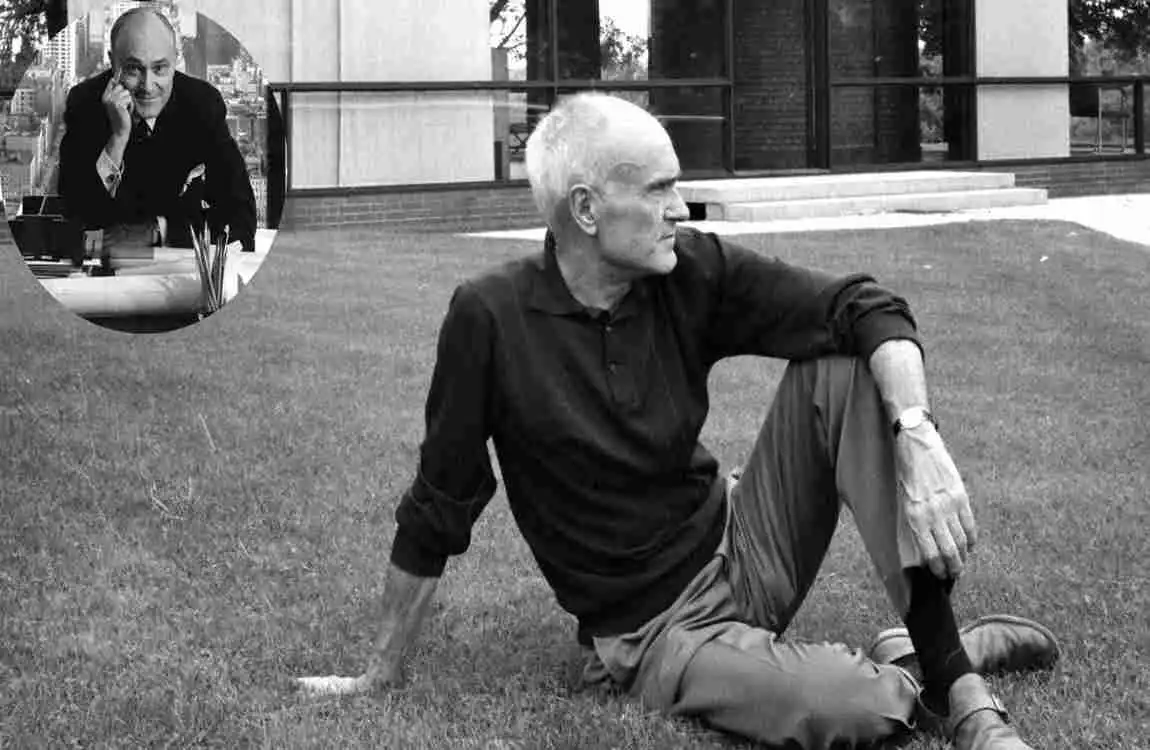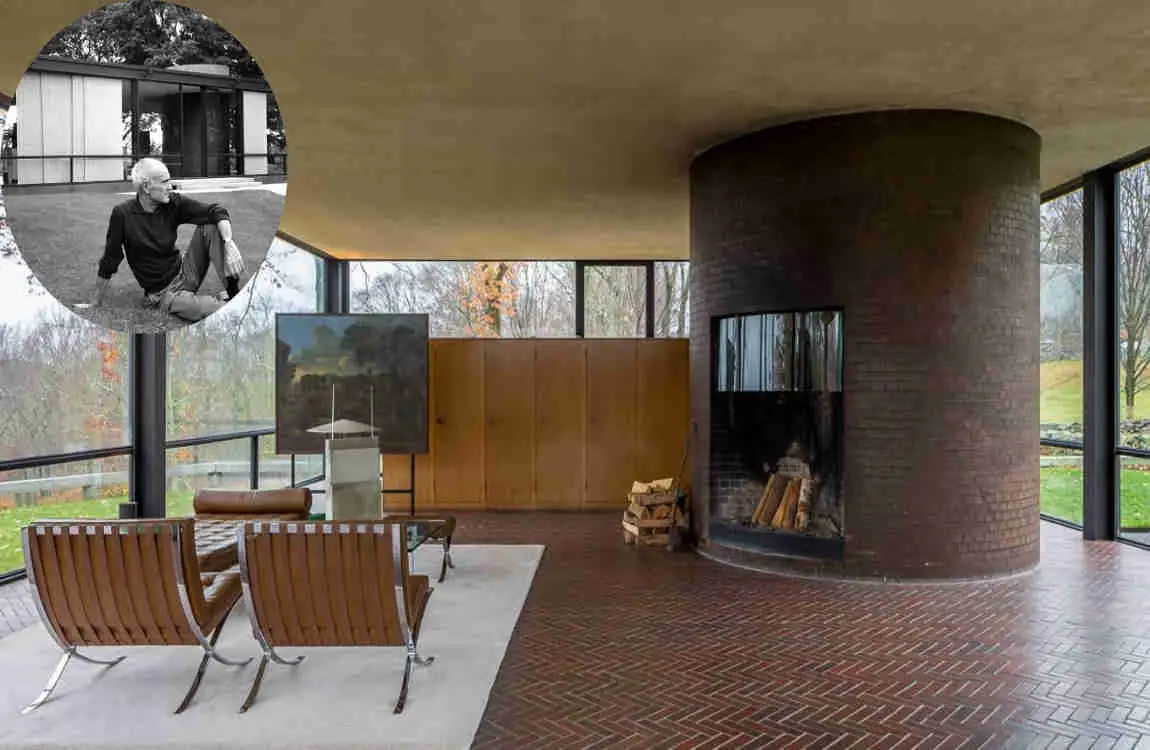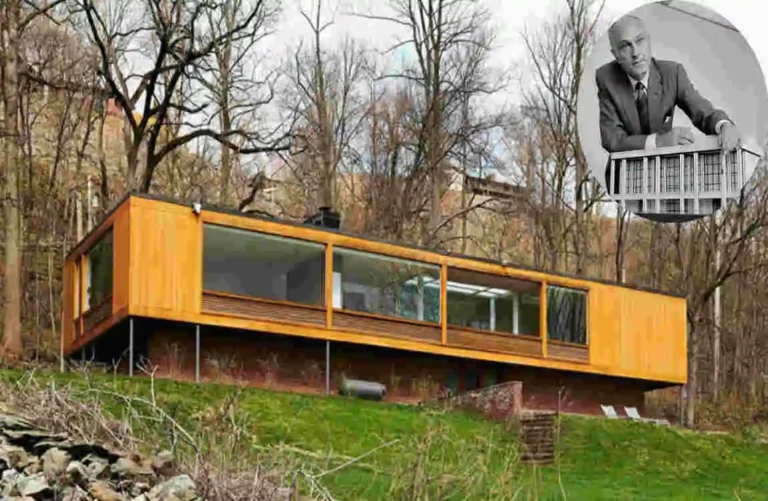Picture this: a home where walls dissolve into transparency, where the boundary between inside and outside becomes a mere suggestion. This isn’t a futuristic fantasy—it’s the revolutionary reality of the Philip Johnson House, a masterpiece that forever changed how we think about residential architecture.
When architect Philip Johnson completed his Glass House in 1949, he didn’t just build a home. He created a bold statement that challenged everything people believed about privacy, comfort, and the very nature of shelter.
| Attribute | Details |
|---|---|
| Full Name | Philip Cortelyou Johnson |
| Date of Birth | July 8, 1906 |
| Place of Birth | Cleveland, Ohio, United States |
| Date of Death | January 25, 2005 |
| Age at Death | 98 years |
| Nationality | American |
| Occupation | Architect, Critic, Museum Director |
| Notable Works | Glass House (New Canaan, Connecticut), Seagram Building (NYC), Booth House (Bedford, NY) |
| Known For | Pioneer of International Style and Postmodern architecture |
| Awards | Pritzker Prize (1979), AIA Gold Medal (1978) |
| Education | Harvard University (Philosophy, Architecture) |
| Family | Parents – Homer Hosea Johnson (father), Louisa Osborn Pope (mother) |
| Net Worth | Not publicly disclosed |
| Last Known Residence | Glass House estate in New Canaan, Connecticut, USA (House now a museum owned by the National Trust for Historic Preservation) |
The Philip Johnson House represents more than just innovative design—it embodies a philosophy that dares to ask: What if our modern homes could be both shelter and art? What if we could live within nature rather than apart from it? These questions continue to resonate today, making Johnson’s creation as relevant now as it was over seven decades ago.
Who Was Philip Johnson?

Before we can truly appreciate the Philip Johnson House, we need to understand the visionary mind behind it. Philip Cortelyou Johnson wasn’t just an architect—he was a cultural provocateur who reshaped American architecture for generations to come.
Born in 1906 in Cleveland, Ohio, Johnson initially pursued philosophy at Harvard before discovering his true passion. His journey into architecture began unconventionally. Unlike many architects who start with formal training, Johnson first made his mark as a curator and critic. He co-authored the groundbreaking book “The International Style” and organized influential exhibitions at the Museum of Modern Art.
Johnson’s career spanned an incredible seven decades, during which he designed everything from skyscrapers to churches. His portfolio includes iconic structures like the Seagram Building (with Mies van der Rohe) and the Crystal Cathedral in California. Yet among all his achievements, many consider his own residence—the Philip Johnson House—to be his most personal and influential work.
What made Johnson unique was his ability to blend intellectual rigor with aesthetic daring. He didn’t just design buildings; he created experiences. His philosophy centered on the belief that architecture should provoke, inspire, and challenge conventional thinking. This approach is nowhere more evident than in his Glass House, where he literally lived his principles.
The Philip Johnson House perfectly reflects his design philosophy: minimalism with maximum impact. Johnson believed that by stripping away unnecessary elements, architecture could achieve a purer form of beauty. His home became a living laboratory where he tested these ideas, proving that radical simplicity could create profound experiences.
Historical Context of the Philip Johnson House
The story of the Philip Johnson House begins in 1945 when Johnson purchased a five-acre property in New Canaan, Connecticut. This wasn’t just a random choice—New Canaan was becoming a hotbed of modernist architecture, attracting forward-thinking architects who wanted to experiment with new ideas.
| Aspect | Details |
|---|---|
| House Name | The Glass House |
| Architect | Philip Cortelyou Johnson |
| Year Built | 1945–1949 |
| Location / Address | 798–856 Ponus Ridge Road, New Canaan, Connecticut, USA |
| Size | Approximately 1,720 – 1,815 square feet (about 160-168 square meters), 55 ft by 33-32 ft dimensions |
| Architecture Style | International Style, Modernist architectural landmark |
| Design Features | – Glass walls on all four sides with centrally located glass doors |
| – Steel frame painted charcoal | |
| – Minimalist interior with open floor plan | |
| – Bathroom contained in a brick cylinder | |
| – Furniture sourced from Mies van der Rohe designs | |
| – Seamless integration with surrounding landscape | |
| Additional Structures | Brick House (for privacy and sleeping), Pavilion on the Pond, Painting and Sculpture Galleries, Study, Ghost House, “Da Monsta” sculpture pavilion |
| History & Significance | – Johnson lived here for nearly 50 years |
| – Considered a masterpiece of the International Style | |
| – Gained recognition for Johnson, featured in major publications | |
| – Influenced by Mies van der Rohe’s work, who was initially unhappy due to similarities | |
| – Donated to the National Trust for Historic Preservation and opened to the public in 2007 | |
| Estimated Worth | Not explicitly specified; recognized as architectural and cultural icon |
Construction of the Glass House began in 1948 and was completed in 1949. The timing was significant. Post-World War II America was experiencing dramatic social and cultural changes. Traditional values were being questioned, and a growing appetite for innovation was emerging. The suburban landscape was expanding rapidly, but most homes still adhered to conventional designs, featuring clearly defined rooms and solid walls.
You may also read (nellys st louis house).
Johnson’s Glass House emerged as a radical departure from these norms. While his neighbors were building traditional Colonial or Tudor-style homes, Johnson created something that seemed to belong in a science fiction novel. The house sits on a gentle slope overlooking a pond, carefully positioned to maximize views while maintaining some privacy from the road.
The architectural climate of the mid-20th century was ripe for experimentation. The International Style was gaining momentum, emphasizing clean lines, open spaces, and the honest expression of materials. European modernists, such as Le Corbusier and Walter Gropius, had introduced revolutionary ideas, but American architects were still finding their own voice.
The Philip Johnson House represented a uniquely American interpretation of modernism. It embraced the movement’s core principles while adapting them to the American landscape and lifestyle. Johnson didn’t just import European ideas—he transformed them into something entirely new.
What made this house truly revolutionary was its complete transparency. In an era when privacy was paramount, Johnson created a home with glass walls on all four sides. This bold choice challenged fundamental assumptions about how we live and what shelter means. The house became an instant sensation, drawing both admiration and controversy.
Architectural Features of the Philip Johnson House

The Glass Envelope
The most striking feature of the Philip Johnson House is, undoubtedly, its complete transparency. The entire structure is enclosed by floor-to-ceiling glass panels, supported by a minimal black steel frame. These aren’t just windows—they’re the walls themselves. Each panel measures precisely 10 feet by 6 feet, creating a rhythmic pattern that gives the house its distinctive appearance.
The glass used isn’t ordinary window glass. Johnson selected quarter-inch plate glass that provides clarity while maintaining structural integrity. The transparency creates an extraordinary effect: from the inside, you feel entirely immersed in nature, while from the outside, the house seems to disappear into its surroundings, particularly at night when the lights reflect off the glass.
Minimalist Structure and Open Floor Plan
Step inside the Philip Johnson House, and you’ll find a single room measuring 32 feet by 56 feet. There are no interior walls except for a cylindrical brick structure that houses the bathroom. This radical openness was unprecedented in residential architecture.
The floor plan is deceptively simple yet brilliantly functional. Johnson divided the space into distinct areas through furniture placement rather than walls:
- Living area with Barcelona chairs and a glass coffee table
- Sleeping area with a simple bed and minimal furnishings
- Kitchen area featuring custom-designed cabinets
- Study area with Johnson’s desk and bookshelves
This arrangement proves that walls aren’t necessary to create functional spaces. Instead, Johnson used subtle design elements, such as area rugs and furniture groupings, to define distinct zones within the open-plan space.
Materials and Construction
The material palette of the Philip Johnson House is remarkably restrained, consisting primarily of:
MaterialApplicationPurpose
The steel frame and supports provide minimal structure while maximizing transparency.
Glass Walls create a complete visual connection with the landscape
Brick Central cylinder and floor add warmth and ground the ethereal structure
Walnut Cabinets and furniture introduce natural texture and warmth
The steel frame is painted charcoal black, creating a graphic contrast against the landscape. The frame isn’t just structural—it’s sculptural, dividing the glass walls into a grid that gives the house its distinctive geometric character.
Integration with Landscape
Perhaps the most genius aspect of the Philip Johnson House is how it relates to its surroundings. Johnson didn’t just place a glass box on the land—he carefully orchestrated a dialogue between architecture and nature.
The house sits on a manicured lawn that extends in all directions, creating a carpet-like setting. Mature trees provide natural screening and frame views from inside. Johnson positioned the house to capture specific vistas:
- Eastern views of the sunrise over the pond
- Western views into a wooded grove
- Northern views of rolling lawns
- Southern exposure for optimal natural light
Innovative Use of Space and Light
Light becomes a building material in the Philip Johnson modern House. Throughout the day, changing light conditions transform the interior experience. The morning sun casts long shadows across the herringbone brick floor. Afternoon light filters through trees, creating dappled patterns. Evening brings a magical quality as interior lights turn the house into a glowing lantern.
Johnson also mastered the art of reflection. The glass walls create multiple layers of visual experience—you see not just through them but also reflections of the landscape behind you. This creates a sense of being surrounded by nature from all angles.
Revolutionary Design Elements
Several features of the Philip Johnson House were revolutionary for their time:
- The entrance: There’s no formal entry hall or vestibule. You step directly from outside into the main living space, emphasizing the minimal barrier between interior and exterior.
- Climate control: Johnson installed radiant heating in the brick floor, eliminating the need for visible radiators that would interrupt the clean lines.
- The bathroom cylinder: The brick cylinder isn’t centered but offset, creating dynamic spatial relationships and preventing the space from feeling too symmetrical.
These features work together to create an environment that’s both radically minimal and surprisingly livable. The Philip Johnson House proves that less truly can be more when every element is carefully considered.
Architectural Genius Behind the Philip Johnson House
The Philosophy of “Less is More”
Philip Johnson’s design philosophy for his Glass House embodies the modernist principle of “less is more”—a concept he adapted from his mentor, Ludwig Mies van der Rohe. But Johnson’s interpretation went beyond mere minimalism. He created a space where every element serves multiple purposes, where absence becomes as crucial as presence.
Consider how Johnson handled privacy—or rather, how he redefined it entirely. Instead of walls, he used the landscape itself as a privacy screen. Trees and topography provide selective screening while maintaining the sense of openness. This approach suggests that privacy isn’t about hiding but about controlling what you reveal and when.
The Philip Johnson House demonstrates that architectural genius lies not in adding complexity but in achieving sophistication through simplicity. Every decision—from the placement of a single chair to the angle of the roof—was deliberate and purposeful.
Inspiration and Influences
Johnson drew inspiration from multiple sources when designing his house. The most obvious influence was Mies van der Rohe’s Farnsworth House, which was being designed around the same time. However, Johnson’s interpretation differed significantly:
- Where Mies elevated his house on stilts, Johnson placed his directly on the ground
- Where Mies used white steel, Johnson chose black
- Where Mies created a floating pavilion, Johnson created an anchored shelter
The Bauhaus movement also profoundly influenced Johnson’s thinking. The school’s emphasis on functional beauty and the integration of art and life resonated deeply with his vision. You can see Bauhaus principles throughout the Philip Johnson House—in its geometric purity, its honest use of materials, and its treatment of space as a flexible medium.
Redefining Residential Architecture
What makes the Philip Johnson House truly genius is how it challenged every assumption about residential design. Johnson asked fundamental questions:
- Why do we need separate rooms?
- What if walls were transparent?
- Can a house be both shelter and sculpture?
- How much privacy do we really need?
His answers to these questions created a new paradigm for residential architecture. The house proved that homes could be works of art without sacrificing livability. It showed that transparency could create intimacy rather than exposure, that openness could feel cozy rather than vast.
Johnson’s genius also lay in understanding that architecture isn’t just about buildings—it’s about experiences. Living in the Glass House means constantly engaging with your environment. The changing seasons become part of your daily life. Weather isn’t something that happens outside; it’s a presence you feel intimately.
The House as Living Laboratory
Perhaps most brilliantly, Johnson designed his house as an ongoing experiment. Over the years, he continued to refine and adjust the space, testing new ideas about how we inhabit architecture. He added new structures to the property—a guest house, a painting gallery, a sculpture pavilion—each exploring different architectural concepts.
This experimental approach influenced generations of architects. The Philip Johnson House became a teaching tool, demonstrating that great architecture requires not just vision but also the courage to live your principles.
Analysis as Art and Function
The true genius of the Philip Johnson House lies in its dual nature as both art object and functional home. From one perspective, it’s a minimalist sculpture, a composition of planes and volumes that happens to be habitable. From another, it’s a carefully crafted living environment that happens to be beautiful.
This duality challenges the traditional separation between art and life. Johnson created a space where daily activities become aesthetic experiences. Making coffee becomes a ritual performed on a stage. Reading a book becomes a meditation on light and shadow. The house transforms mundane activities into conscious acts.
Legacy and Influence of the Philip Johnson House
Shaping Modern Residential Design
The impact of the Philip Johnson House on contemporary architecture is undeniable. It sparked a revolution in residential design that continues to influence architects today. The house introduced several concepts that have become fundamental to modern architecture:
Open floor plans are now standard in contemporary homes. While most houses don’t take transparency to Johnson’s extreme, the idea of fluid, flexible spaces has become mainstream. Today’s great rooms and loft apartments owe a debt to Johnson’s radical experiment.
The emphasis on connecting indoor and outdoor spaces has also become a defining characteristic of modern design. Floor-to-ceiling windows, sliding glass walls, and outdoor rooms all trace their lineage back to the Philip Johnson House. Architects worldwide now prioritize this connection, understanding that it enhances both aesthetic appeal and quality of life.
Preservation and Historical Significance
In 1997, the Philip Johnson House was designated a National Historic Landmark, recognizing its profound importance to American architecture. The National Trust for Historic Preservation now manages the property, ensuring its preservation for future generations.
The preservation efforts go beyond simply maintaining the building. They include:
- Careful restoration of original materials and finishes
- Documentation of Johnson’s design process and modifications
- Conservation of the surrounding landscape
- Educational programs that share Johnson’s vision
This meticulous preservation ensures that visitors can experience the house as Johnson intended, understanding not just what he built but why he built it.
Educational Impact
The Philip Johnson House has become one of the world’s most important architectural education sites. Architecture students from around the globe make pilgrimages to New Canaan to study this masterpiece firsthand. The house teaches lessons that can’t be conveyed through photographs or drawings:
- How scale and proportion create spatial harmony
- How transparency can paradoxically create intimacy
- How minimal design requires maximum precision
- How architecture and landscape can merge seamlessly
Universities regularly include the house in their curriculum, using it as a case study for everything from structural engineering to design theory. The house has inspired countless thesis projects and continues to spark new interpretations and analyses.
Global Recognition and Study
Internationally, the Philip Johnson House is recognized as one of the most significant buildings of the 20th century. It appears in virtually every comprehensive survey of modern architecture and has been featured in hundreds of books, documentaries, and exhibitions.
Architects from Japan to Brazil cite the Glass House as an influence. Its impact can be seen in:
- Tadao Ando’s concrete houses that play with transparency and opacity
- Renzo Piano’s light-filled structures that blur inside and outside
- Norman Foster’s high-tech interpretations of transparency
- Kazuyo Sejima’s ethereal glass pavilions
Contemporary Relevance
What makes the Philip Johnson House particularly relevant today is how it addresses contemporary concerns about sustainability and connection with nature. While Johnson wasn’t explicitly thinking about environmental issues in 1949, his design principles align remarkably well with current sustainable design practices:
The house’s compact footprint minimizes land use. Its orientation maximizes natural light and passive solar heating. The integration with the landscape creates a model for site-sensitive design. These aspects make the house surprisingly forward-thinking from an environmental perspective.
Modern architects studying the Philip Johnson House find inspiration for addressing today’s challenges. How can we create homes that are both minimal and comfortable? How can we reduce our environmental impact while maintaining quality of life? Johnson’s house provides enduring answers to these questions.
Visiting and Experiencing the Philip Johnson House
Planning Your Visit
Experiencing the Philip Johnson House in person is transformative. The Glass House visitor center in New Canaan offers several tour options, each providing different perspectives on Johnson’s architectural vision. Tours run from May through November, with reservations required due to limited capacity.
The introductory tour includes the Glass House and Painting Gallery, lasting about 90 minutes. For deeper exploration, consider the extended tours that include additional structures on the property. Each building reveals different facets of Johnson’s evolving architectural philosophy.
Practical visitor information:
- Tours depart from the visitor center in downtown New Canaan
- Comfortable walking shoes are essential
- Photography is permitted for personal use
- Tours proceed rain or shine
What to Expect During Your Visit
Approaching the Philip Johnson House for the first time is an unforgettable experience. The structure seems to materialize gradually from the landscape, its transparent walls creating an almost ethereal presence. The careful choreography of the approach—designed by Johnson himself—builds anticipation leading up to the complete revelation.
Inside, guides share stories about Johnson’s life in the house, bringing the space to life through personal anecdotes. You’ll learn about his daily routines, his legendary parties, and how he actually lived in such a transparent environment. These human details make the architectural achievement even more remarkable.
The tour also reveals subtle details that photographs can’t capture:
- How the steel frame creates shadow patterns throughout the day
- The way sounds travel in the open space
- The temperature variations in different areas
- The surprising sense of shelter despite the transparency
Tips for Architecture Enthusiasts
To maximize your visit to the Philip Johnson House, consider these insider tips:
Visit during different seasons if possible. The house undergoes dramatic transformations with the passage of each season. Spring brings flowering trees that create natural curtains. Summer provides lush green screening. Fall offers spectacular color. Winter reveals the house’s pure geometric form against the snow.
Time your visit carefully. Morning tours offer the best light for photography and show how Johnson experienced his morning routine. Late afternoon tours capture the magical “golden hour” when the house glows from within.
For photographers, the Philip Johnson House presents unique challenges and opportunities. The reflective glass creates complex layered images. The best shots often come from unexpected angles that capture both transparency and reflection. Don’t just photograph the house—capture how it frames the landscape.
Enhancing Your Understanding
To truly appreciate Johnson’s genius, take the time to observe how the house functions. Notice how different areas feel despite the lack of walls. Pay attention to how your eye moves through the space. Consider how you would live in such a transparent environment.
The visit offers insights that extend beyond the realm of architecture. The Philip Johnson House raises questions about privacy, lifestyle, and our relationship with the natural world. It challenges visitors to reconsider their own living spaces and what they truly need versus what convention dictates.
Many visitors report that experiencing the house changes their perception of architecture. They leave with a new appreciation for how design shapes daily life and how radical simplicity can create profound beauty.
Where Does Philip Johnson Currently Live?
Philip Johnson resided at his iconic Glass House for many years, situated on Ponus Ridge Road in New Canaan, Connecticut. He designed the Glass House as his own residence and lived there until he died in 2005. The house is now a historic house museum owned by the National Trust for Historic Preservation and is open to the public for guided tours. Since Philip Johnson passed away in 2005, he is no longer alive. At the time of his death, his residence was the Glass House in New Canaan, Connecticut.
You may also read (inside dale earnhardt jr s iconic lake norman lakehouse nascar legends luxury retreat and family legacy).

